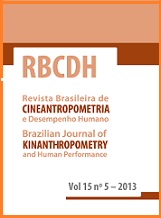Overweight, abdominal obesity and associated factors in technical administrative servants
DOI:
https://doi.org/10.1590/1980-0037.2013v15n5p535Abstract
The objectives of this study were to determine the prevalence rates of excess weight and abdominal obesity among technical and administrative staff at the Universidade Federal de Santa Catarina (UFSC) using a range of different anthropometric indicators and to identify sociodemographic factors associated with these rates. This was a cross-sectional study of 615 members of staff at UFSC (283 men and 332 women). The following anthropometric indicators were analyzed: body mass index (BMI), waist circumference (WC) and waist to height ratio (WHtR). The following sociodemographic variables were also analyzed: age, sex, skin color, marital status, socioeconomic status, educational level and employment grade. Statistical analysis was conducted using Student’s t test, the Mann-Whitney U test and Poisson regression (with a 95% confidence interval). Prevalence rates for men and women respectively were as follows; excess weight: 63.6% and 49.7% (BMI); abdominal obesity (WC): 33.5% and 42.4%; and abdominal obesity (WHtR): 61 .8% and 40.6%. Age greater than 40 years was associated with a higher probability of excess weight and abdominal obesity in men (by BMI and WHtR) and women (by BMI, WC and WHtR). Women who had spent 8 years or fewer in education had lower probabilities of excess weight (PR=0.67; 95%Cl=0.49; 0.94) and abdominal obesity, by both WC (PR=0.62; 95%Cl=0.44; 0.90) and WHtR (PR=0.49; 95%Cl=0.39; 0.64). These results indicate an elevated prevalence of excess weight and abdominal obesity and show that the factors associated with these outcomes vary by sex and depending on the anthropometric indicator analyzed.



